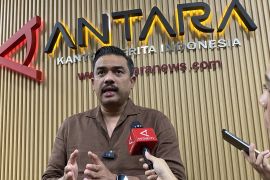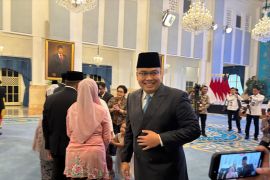"There are more than 10 districts whose local governments are cooperating with PLN to make the rural electrification program a success," PLNs director for Maluku and Papua provinces, Ahmad Rofiq, said in Jakarta on Tuesday (Sept 19).
The Indonesian government is currently launching its electrification program called "Indonesia Terang" (Indonesia Bright), with a target to provide electricity for 10.3 thousand villages until 2019, or about 97.35 percent of the countrys electrification ratio.
Rofiq stated that the cooperation held with the local governments to accelerate the rural electrification program is aimed to meet the need for power supplies of PLNs 450 watt subscribers, with a capacity of 300 kWh, especially in the Indonesian eastern regions.
The government, in its "Indonesia Terang" program, gives an emphasis on villages in the Indonesian eastern regions. Until last year, some 67 percent of the Indonesian rural electrification program covered the Indonesian eastern regions that stretch from West Nusa Tenggara Province (NTB) to Papua.
According to Rofiq, the governments rural electrification program has been implemented progressively and rapidly, particularly in villages that are not yet covered by electricity supplies or those that are already covered but still need more.
If in 2015, the number of villages already covered by electricity supplies was recorded at 70,391 villages across the country, and the number of villages already receiving power supplies has reached 73,149 until Aug 2017.
In implementing the governments rural electrification program, the PLN has divided the areas of electrification into seven regional division consisting of Sumatra, Java-Bali, Kalimantan, Sulawesi, Nusa Tenggara, Maluku, and Papua provinces.
Sumatra covers 27,814 villages; Java-Bali covers 27,012 villages; Kalimantan covers 6,047 villages; Sulawesi covers 5,982 villages; Nusa Tenggara covers 3,189 villages; Maluku covers 1,715 villages; and Papua covers 1,390 villages.
The government, through PLN, has also divided the village electrification program into two categories, namely expansion and new electrification programs. In its expansion program, PLN has provided more electricity access to customers in villages that have previously received power supplies. In the meantime, for its new electrification program, PLN has provided electricity for villages that have never been supplied with power supplies or had no access to electricity at all.
Based on PLN data until Aug 2017, the government has provided rural electrification program to the Sumatra Region, covering 232 villages for expansion and 355 villages for new power supplies; Java - Bali Region, with 2,276 villages for expansion and 515 villages for new supplies; Kalimantan, with 122 villages (expansion) and 87 villages (new installation); Sulawesi Region, with 441 villages (expansion) and 301 villages (new electrification); Nusa Tenggara Region, with 64 villages (expansion) and 528 villages (new power project); Maluku Region, with 7 villages (expansion project) and 212 villages (new power projects); and Papua, with 327 villages (all are new).
The government in 2018 is planning to provide electricity expansion projects for 1,530 villages across the country and another new power projects for 3,523 villages. In the meantime, in 2019, the government will supply additional power expansion projects for 1,370 villages and new electricity supply projects for 1,605 villages in all regions.
Besides launching rural electrification, the government also continues to develop power plants to increase the countrys electricity capacity.
The government, since the start of President Joko Widodos administration in Oct 2014, has set a target to build power plants, with a total capacity of 35 thousand megawatts (MW) by 2019.
With the current national power capacity of 51 thousand MW, the implementation of the 35 thousand MW project is expected to increase the national power capacity to 86 thousand MW.
However, after about 2.5 years of administration, the programs target seems unlikely to be achieved in 2019. The most ideal capacity that could be realized under the program until 2019 is only about 19 thousand-20 thousand MW. Hence, by that time, the total national electricity capacity is forecast to reach 70 thousand to 75 thousand MW.
Though the target is unlikely to be achieved in 2019, the government will continue to build power plants until the 35 thousand-MW target is achieved.
"A capacity of 19 thousand-20 thousand MW is the most logical one that could be achieved in 2019," Arcandra Tahar, the deputy energy and mineral resources minister, noted in a discussion on the harmony of the national and regional general energy plans for national energy resilience and reliance at the Gajah Mada Univeristy, Yogyakarta, on April 24.(*)
Reporter: Andi Abdussalam
Editor: Heru Purwanto
Copyright © ANTARA 2017











